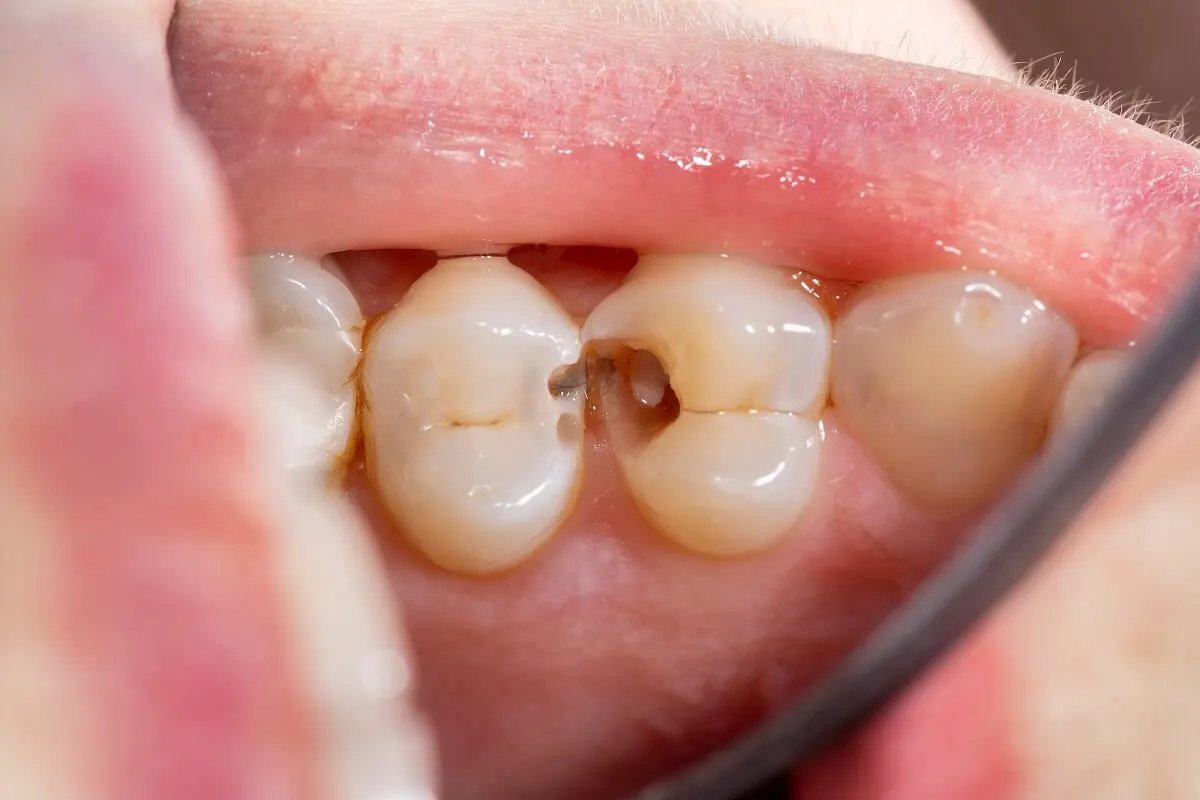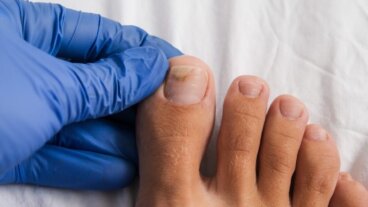What Is Tooth Sealing and What Is it Used For?


Written and verified by the dentist Vanesa Evangelina Buffa
Tooth sealing is a preventive measure against tooth decay. Together with the application of fluoride, it’s a simple procedure performed by the dentist to reduce the risk of suffering from this disease.
Tooth surfaces with irregularities often can’t be reached with a toothbrush. Since these areas can’t be adequately cleaned, they retain bacteria and food debris. This increases the risk of caries developing in these areas.
The placement of sealants on the pits, grooves, and fissures of the teeth acts as a protective barrier. This reduces the risk of tooth decay.
Read on to learn more about dental sealants. We’ll you what they consist of, why they’re used, and what the procedure is like.
What is tooth sealing?
As we mentioned before, teeth have irregularities on their surface. This is more noticeable in teeth that have just come through. The lack of use makes the fissures, pits, and grooves of the occlusal surface deep and difficult to clean.
Tooth sealing consists of placing a thin coating of a special material over these irregular areas. By filling in these imperfections, it reduces the retention of bacteria and food remains in the area; it also favors the cleaning of the dental element.
In general, they’re placed on the chewing surface of permanent molars and premolars. This is the area where most cavities develop in these teeth. However, in some cases, the procedure can be applied in other areas where plaque accumulates easily, or in temporary teeth if the risk of caries is very high.
The procedure is painless, very fast, and comfortable for the patient. And since it’s a minimally invasive procedure, there’s no need for anesthesia.
There are different materials that can be used for sealing. In most cases, fluid resins are chosen that harden with a special light; these are transparent, white, or the same color as the tooth. However, some dentists prefer to use vitreous ionomers.
Why is tooth sealing performed?
Tooth sealing is performed to prevent caries, especially those located on the occlusal surfaces of posterior permanent teeth. According to research, one year after sealing teeth in children, the incidence of this oral disease decreases by 80%.
And, according to the Centers for Disease Control and Prevention (CDC), dental sealants protect against 80% of caries for 2 years. And they continue to do so up to 50% for up to 4 years.
Tooth decay is one of the most common pathologies worldwide and can affect people of any age. It is the demineralization of enamel and dentin due to the action of acids produced by bacteria in the mouth when metabolizing sugars in the diet.
The areas where bacteria accumulate and proliferate are the most susceptible areas to developing the disease. The chewing areas of the molars that have rough parts with deep grooves and fissures and where the toothbrush can’t reach are a clear example.
Therefore, by placing dental sealants on the areas that retain bacteria, the irregular occlusal anatomy is changed. The material the deep areas are filled with acts as a protective barrier and allows cleaning.
Dental sealants prevent food remains, bacterial plaque, and acids that trigger cavities from accumulating and remaining on the teeth. In this way, it prevents the development of cavities. And, as a result, the patient is spared the discomfort, time, and money required for treatments to treat the disease when it occurs.

You may be interested in: 10 Natural Methods to Get Rid of Dental Plaque
When are dental sealants recommended?
Only a dentist can recommend dental sealants. They will decide if this preventive measure is necessary, according to the patient’s risk of suffering from tooth decay.
They will consider the dental anatomy, systemic diseases, and the history of tooth decay, as well as the eating and hygiene habits that may or may not predispose the patient to suffer from tooth decay. Using this information, they will decide if it’s a good idea to perform the sealing or not, and, if so, how many teeth should be sealed.
In general, it’s recommended to seal the permanent molars as soon as they finish coming through. And in patients with a high caries risk, premolars are also included. Because of this, it’s a commonly used measure in children and adolescents.
In patients who have badly-positioned or deformed teeth that favor the accumulation of bacterial plaque, it’s also advisable to consider this procedure. It’s also a useful preventive measure for children with disabilities or underlying systemic pathologies.
However, it’s important to realise that, when it comes to dental sealants, there are some conditions that must be met and they’re as follows:
- Sealants can only be placed on healthy teeth or teeth with tooth decay that has recently started.
- The tooth to be sealed must have fully erupted in order to receive the treatment. Otherwise, you must wait until it has finished erupting and is no longer covered by the gum.
- Sealants are not placed over fillings. If the tooth is already fixed, then it won’t be sealed.
Benefits of dental sealants
Prevention of tooth decay is the main benefit of tooth sealing. But it has other advantages too:
- They can be used in children, adolescents, and adults: The most common thing is to apply them during childhood and adolescence, when the teeth finish coming out. But they can also be applied in adults if the dentist considers it appropriate.
- They’re useful on any surface that retains bacterial plaque: Although they’re most frequently placed on pits, grooves, and fissures on the surfaces of molars and premolars, they can be used on any dental defect that’s difficult to clean.
- Simple technique: Applying the sealants only requires the patient to remain with their mouth open for a moment. It doesn’t hurt, doesn’t require anesthesia, is performed quickly and in a single session.
- They’re applied at an early age: As it’s a procedure without anesthesia, fast, painless, and comfortable, it can be used as soon as the teeth appear. This occurs at around 6 years of age for the first ones and at 12 years of age for the second ones.
- They are esthetic: The resins used for sealing teeth are transparent, white or with a color similar to the tooth, so they go unnoticed.
Discover more here: 11 Easy Ways to Prevent Tooth Decay
How is tooth sealing performed?
As we already told you, the technique for placing dental sealants is quick, simple and comfortable. Once the dentist decides to apply this preventive measure, they start by cleaning the tooth surfaces with a special paste and rotating brushes. They’ll then rinse with water and dry the teeth.
Subsequently, they’ll need to condition the tooth surface with an acid gel that creates a rough surface with microscopic pores that favor the adhesion of the material. This substance is left to act for a few seconds, then washed off and dried.
Now the dentist will place the flowable resin on the deep surfaces of the tooth element. The material will drain and fill the grooves, pits, and fissures of the tooth.
For the material to harden, it must be light cured. In order to do this, a special halogen light is applied for a few seconds.
And once hardened, the patient’s bite is tested. This allows the specialist to check that the occlusion is correct, and that there are no interferences. If necessary, the excess material is filed down.
And so, in just one visit the seal is ready and the patient can use his or her protected tooth (or teeth) normally. Periodic check-ups will be necessary to check that the sealants are still in place, in good condition, or if they need to be renewed.
Sealants remain in the mouth for long periods of time; some can last between 5 and 10 years. However, this depends on the correct placement technique and subsequent maintenance.
If at any time the patient feels discomfort when biting or that the material has come out, they’ll need to visit the dentist. It’s possible to repeat the procedure on the same dental element to keep it protected.

Sealant maintenance
We have already told you that once the dental sealants have been applied, it’s advisable to evaluate them periodically and check that they haven’t come out or worn out. Dental visits every 6 months will ensure that everything is going well.
It’s also advisable to complement the treatment with the use of fluorides. This element strengthens the tooth enamel and thus also prevents cavities. The dentist will determine the best way to incorporate the mineral according to the patient’s needs.
But to maintain this preventive measure and avoid cavities, you’ll need to maintain oral care habits at home. The correct brushing of teeth, the use of fluoride toothpaste, the use of dental floss, and a varied and healthy diet are essential in order to maintain oral health.
As you’ll have seen today, if you complement tooth sealing with the usual oral care, then preventing cavities, and having healthy teeth is possible.
All cited sources were thoroughly reviewed by our team to ensure their quality, reliability, currency, and validity. The bibliography of this article was considered reliable and of academic or scientific accuracy.
- Moreno Díaz, K. E., & Huilca Villagómez, M. S. (2019). Prevalencia de caries en los primeros molares permanentes en escolares de 6 a 12 años (Bachelor’s thesis, Universidad de Guayaquil. Facultad Piloto de Odontología).
- Reyes Romagosa, D. E., Baños Toirac, I. J., Sánchez Iturriaga, M. E., & Rodríguez Martínez, B. M. (2013). Caries dental aguda del primer molar permanente en niños de 12 años. Revista cubana de estomatología, 50(3), 292-301.
- Sealants, R. B. (2018). Dental sealants Part 3: Which material? Efficiency and effectiveness. European journal of paediatric dentistry, 19, 247.
- Kühnisch, J., Bedir, A., Lo, Y. F., Kessler, A., Lang, T., Mansmann, U., … & Hickel, R. (2020). Meta-analysis of the longevity of commonly used pit and fissure sealant materials. Dental Materials, 36(5), e158-e168.
- Donna Fabre, M. G., Fernandez, A. L., & Peña, J. (2014). Evaluación de selladores de fosas y fisuras realizados con resina y con ionómeros vítreos. Revista de la Facultad de Odontología, 8(1).
- Padrón, M. D. L. Á. G., Guzmán, M. S., Hernández, D., & González, E. (2002). Los Sellantes de Fosas y Fisuras: Una alternativa de tratamiento” Preventivo o Terapéutico” Revicion de la literatura. Acta odontológica venezolana, 40(2), 33-34.
- Behroozian, A., Aghazadeh, Z., Sadrabad, Z. K., Aghazadeh, M., Alizadeh, V., Esmaili, Z., & Ashraf, M. P. (2021). Evaluation of the success rate of pit and fissure sealants on first molars, 12 months follow‐up study. International Journal of Dental Hygiene.
- Mondragón Rivas, D. Y. (2021). Estado de los sellantes de fosas y fisuras colocados en piezas dentales de pacientes atendidos en la clínica de odontopediatría II UNAN-León en el periodo del II semestre 2019 (Doctoral dissertation).
- Cvikl, B., Moritz, A., & Bekes, K. (2018). Pit and fissure sealants—a comprehensive review. Dentistry journal, 6(2), 18.
- Naaman, R., El-Housseiny, A. A., & Alamoudi, N. (2017). The use of pit and fissure sealants—A literature review. Dentistry journal, 5(4), 34.
- Plaza Vera, D. V. (2011). SELLADORES DE FOSAS Y FISURAS (Bachelor’s thesis, Universidad de Guayaquil. Facultad Piloto de Odontología).
This text is provided for informational purposes only and does not replace consultation with a professional. If in doubt, consult your specialist.








